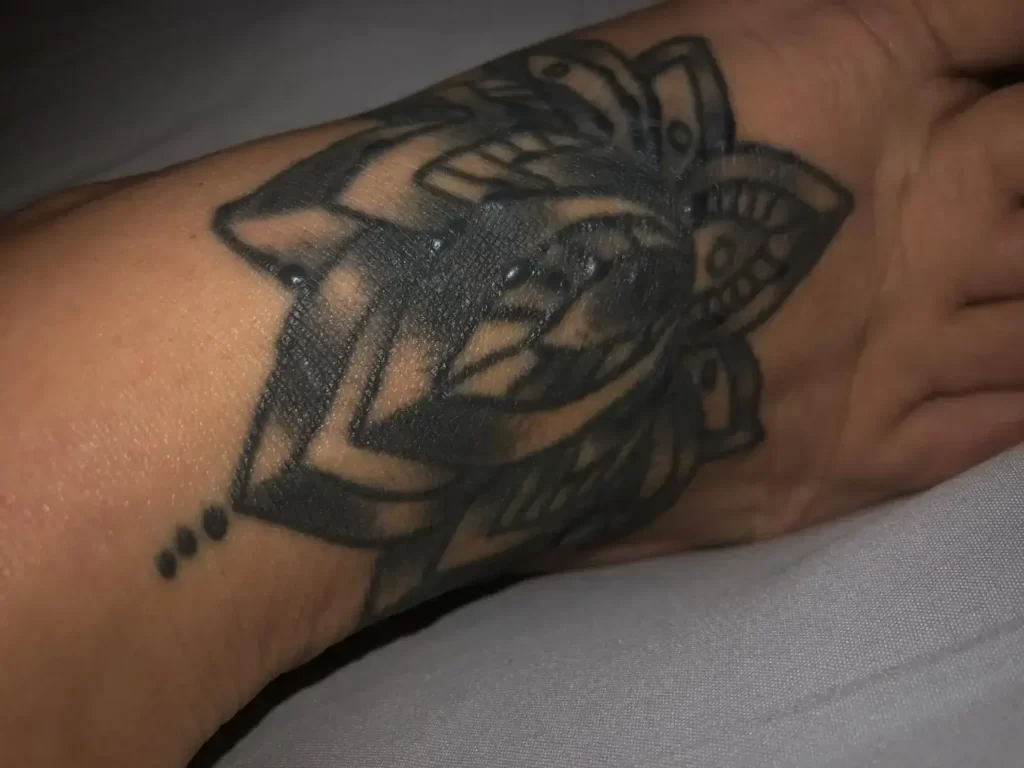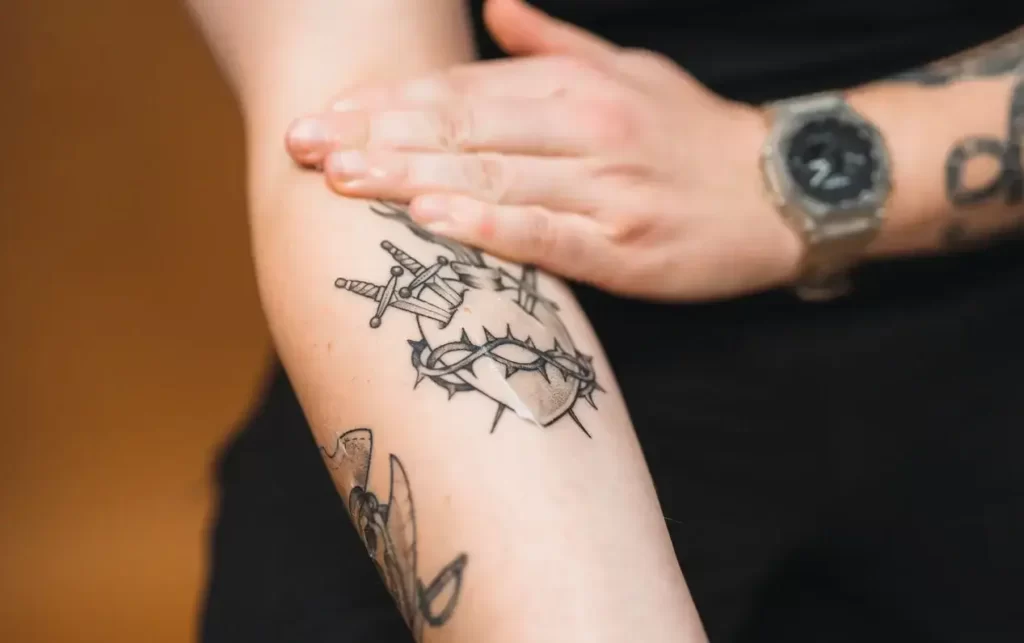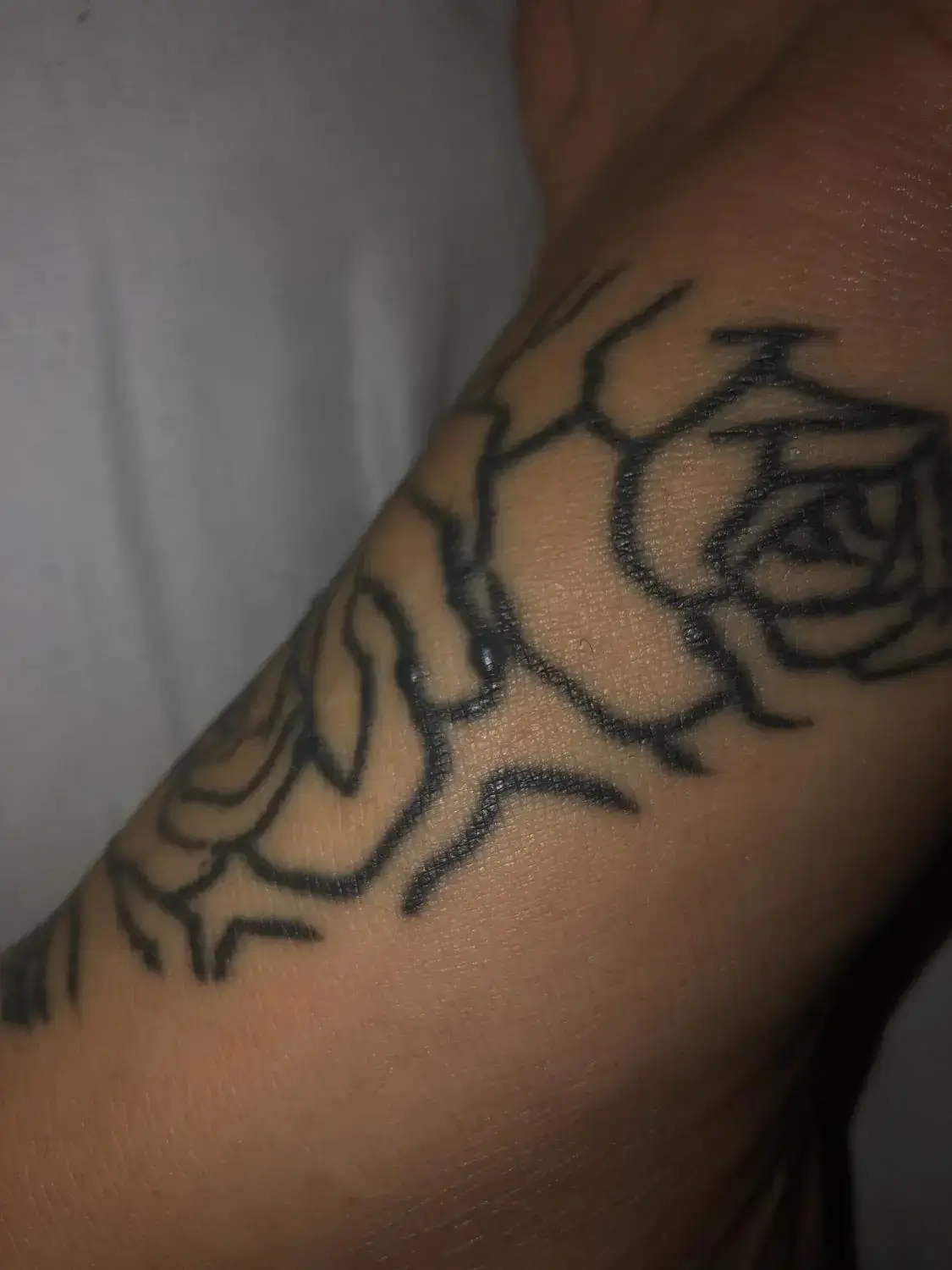When you notice little bumps on tattoo after healed, it’s not just an anomaly; it’s a common side effect that many experience.
These bumps can manifest as itchy, red patches, resembling a mild skin rash, and are a typical part of the skin irritation one might encounter.
As someone who’s navigated this frustration firsthand, I can attest to the pain and irritation these bumps bring. They are a signal from your body, responding and adjusting to the new artwork.
It’s crucial to follow a proper aftercare routine to mitigate these effects and understand that while these bumps and rashes are generally not dangerous, they are indeed a sign from your skin, urging you to pay attention.
This process of receiving a tattoo and experiencing the aftermath isn’t just about aesthetics; it’s about how your body and skin react and adapt to the change.
Also Read: Unlock The Secret: Why Is My Tattoo Shiny And What It Means For You?
Why Does My Tattoo Have Bumps?
When your tattoo has healed but still sports bumps, it’s often a sign your skin is reacting to the ink.
Think of it as a foreign object; the body’s immune system might warn you by creating a reddish, bumpy area known as a tattoo rash.
If you have a history of skin conditions like psoriasis or eczema, these might exacerbate the situation.
Dry skin, in particular, can react more, so keeping the area moisturized is essential. Yet, not all bumps are due to your body’s natural reactions.
Sometimes, they can be a sign of an infection, especially if the tattoo artist didn’t properly sanitize their equipment, leading to bacterial or fungal issues.
Good aftercare is crucial, involving keeping the area clean and using tattoo artist-approved antibacterial ointments and lotions to prevent the formation of more serious rashes.
However, not all bumps are inherently dangerous. Some might just be your skin’s way of adjusting to the new ink. But it’s always better to be safe than sorry.
If you’re noticing persistent or worsening bumps, it’s wise to seek a professional explanation.
This might involve a consultation with your tattoo artist or a dermatologist, especially if you suspect your aftercare routine might not have been up to par or if you’ve been exposed to unsanitary conditions.
Remember, your skin is as unique as your tattoo, and how it heals can vary greatly from person to person.
Also Read: Can You Get A Tattoo On Accutane

Why Is My Tattoo Bumpy: Causes & Reasons
Here are the possible causes and reasons of bumps on tattoos:
1. Naturally Dry Skin
From personal experience, I know how naturally dry skin can cause a tattoo to become irritated.
Friends with eczema or psoriasis have shared how these conditions can make the skin around their tattoos feel especially dry and bumpy.
Keeping the area well-moisturized is key to minimizing this irritating rash. Regular, gentle cleansing helps keep it clean and less prone to irritation.
2. Infection
I’ve learned the hard way that not every tattoo artist is as diligent as they should be in sanitizing their equipment.
A poorly done aftercare process can lead to a painful and irritating rash indicative of an infection.
It’s not just the discomfort; these skin issues can detract from the beauty of your art.
Always insist on seeing your artist’s sanitation process and follow their aftercare advice closely.
3. Immune System Response
A friend’s experience reminded me that the body sees tattoo ink as a foreign object, and the immune system’s response can create a red, bumpy rash.
This reaction is your skin signaling it’s adjusting to the new addition.
Maintaining a clean and moisturized environment helps the skin cope with this change and can reduce the severity of the reaction.
Also Read: Radiant Results: How Long After A Tattoo Can You Tan Without Risk
4. Sun Exposure
As someone who loves the outdoors, I’ve learned that sun exposure can be particularly detrimental to a new tattoo.
The skin becomes extra sensitive after getting inked, and leaving it covered is crucial to avoid sun-induced red, bumpy rashes.
It’s vital to protect the area with tattoo artist-approved sunblock.
I remember neglecting this once and the discomfort and prolonged healing that ensued; it’s a mistake you only make once!
5. Allergic Reactions
I’ve seen a few rare cases where allergic reactions occurred due to a specific dye in the tattoo ink. This can lead to an irritating, painful rash with swelling.
Knowing your allergies, especially to certain dyes, is crucial. Always speak with your tattoo artist beforehand to procure hypoallergenic ink if you have a history of skin sensitivities.
It’s a small step that can make a big difference in avoiding an uncomfortable reaction.
Also Read: Can I Put Fake Tan On A Week Old Tattoo Safely
What To Do If You Have Bumps On Your Tattoos?
If you’re experiencing bumps on your tattoo, it’s crucial to understand the cause. A tattoo rash might be a sign of a mild allergic reaction to the ink.
In such cases, an over-the-counter antihistamine or tattoo artist-approved anti-allergy ointment might provide a solution.
From my own mishaps with a new tattoo, I learned that identifying the cause early on can greatly affect the treatment’s effectiveness.
If you’ve developed a skin infection, it’s important to see a doctor who can prescribe antibacterial medication to fight the infection.
Using a cold compress can also reduce swelling and skin irritation.
If you suspect your bumps are due to sun exposure, applying an aloe vera-based cream or lotion can ease the pain and keep the area moisturized.
Remember, the problem might not just be on the surface; an underlying skin condition could be causing discomfort.
In such scenarios, consulting a dermatologist for a topical ointment or other treatments is wise.
They can help soothe the irritation and provide guidance tailored to your skin’s needs.
Also Read: Is Bactine Good For Tattoos
How To Prevent Bumps On Your Tattoos?
To prevent bumps on your tattoos and minimize skin discomfort or irritation, start by ensuring your tattoo and the area around it are kept clean and sanitized.
Properly moisturized skin is less prone to infection and skin irritation, making it feel better and heal faster. If you do feel pain or see swelling, a cold compress can soothe the area.
Always use tattoo artist-approved ointments, gels, and lotions designed to combat any adverse reactions and keep the skin healthy.
From my own experience, following these steps diligently not only preserves the art but also significantly reduces the risk of unsightly bumps.
Little White Bumps On Tattoo
Tattoo White bumps can develop as the body is adjusting to the ink underneath the skin, and while they often go away over time, they might indicate an underlying skin condition.
These white bumps are generally not a sign of serious skin irritation or pain, but if the issue persists, it’s wise to consult a medical professional.
From personal observation and discussions with experts, I’ve learned that gentle care and monitoring are key during the healing process to ensure these bumps don’t evolve into larger concerns.
Bumps On Tattoos After Years: What You Should Know
Bumps on tattoos even years after getting inked can be disconcerting. If you’re noticing irritated skin around an old tattoo, it’s more common than you might think.
A likely explanation is sun exposure over a long time. Skin can regain its original UV tolerance level only to a certain extent, and an old tattoo can become a rash-prone area if exposed too much.
This doesn’t mean your tattoo is permanently damaged, but it’s a sign that your skin has become sensitive to UV rays.
Using protective sunblock and lotions can help protect both your skin and the vibrancy of your tattoo.
My own experience with a decade-old tattoo emphasizes the importance of regular care and protection, no matter how old the ink is.
Also Read: Tattoo Scab Fell Off Raw Skin Underneath Revealed!

FAQs About Little Bumps On Tattoo After Healed
1. Why Itchy Bumps On My Tattoo Months Later?
Itchy bumps on a tattoo even months later can be due to an allergic reaction. This type of rash can appear as red, bumpy, and itchy symptoms that emerge some days after the tattooing process. To treat this, a steroid ointment may be recommended to alleviate the itchiness and reduce inflammation.
2. Why Do I Have Bumps On Tattoo After Years?
Bumps on a tattoo after years often indicate Allergic Reactions where the area may itch or swell, resembling a rash. This is usually a mild case of itchy skin, but if it persists, a steroid cream can be applied to manage the reaction. If the bumps continue for weeks, it’s advisable to consult a doctor.
3. Why Is My Healed Tattoo Getting Bumps?
Even a healed tattoo getting bumps can be due to the immune system identifying the pigment in the tattoo ink as a threat. The cells in the area might fight back and clump together, forming nodules known as granulomas. If concerned, it’s best to see a doctor for advice.
4. How Long Do Tattoo Bumps Last?
Tattoo bumps can be mild to moderate and the resulting rash may last a week or two. If the rashes persist or lead to scarring or swelling in the tattoo area, it’s important to consult a doctor. While healing, it’s normal for the area to be slightly raised, but it usually disappears without a need to worry.
5. How Do You Get Rid Of Granuloma On A Tattoo?
To get rid of a granuloma on a tattoo, which is quite common, the treatment may involve surgically scraping off the granuloma and sealing any bleeding. It’s a procedure typically done by a medical professional when topical treatments don’t work.
Also Read: Tegaderm Vs Saniderm: Fortify Your Ink With The Ultimate Defense
Final Thoughts
In summary, when it comes to little bumps on tattoo after healed, the bottom line is that tattoo rashes are relatively normal and often not a cause for worry.
It’s important to keep your tattoo well-moisturized, clean, and protected from the sun.
The aftercare process plays a crucial role in the health of your tattooed skin, requiring a step-by-step approach to ensure proper healing.
While these bumps can be a minor nuisance, they usually aren’t a reason to worry.
Understanding the various reasons behind these bumps and how to effectively manage them helps in maintaining both the beauty and health of your tattoos long after they have healed.
